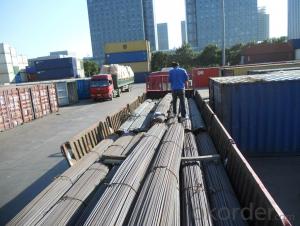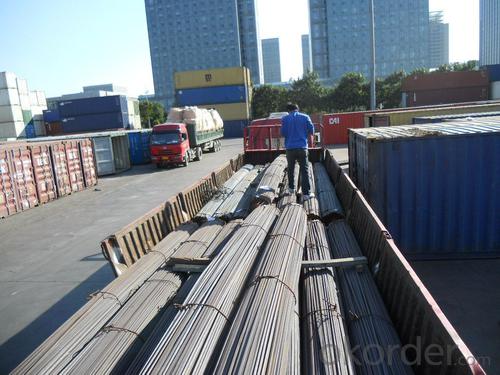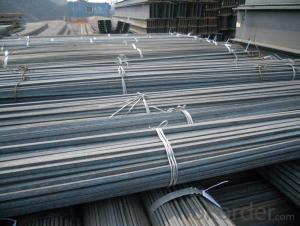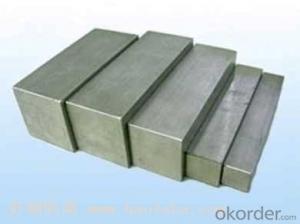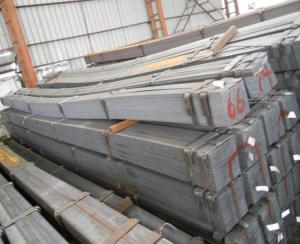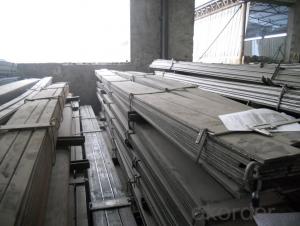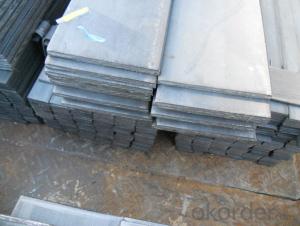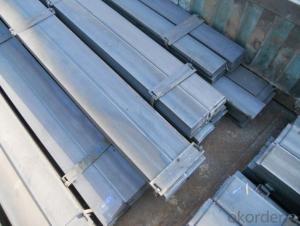Stainless Steel Square Bar with Grade Q235 and Q275
- Loading Port:
- China Main Port
- Payment Terms:
- TT or LC
- Min Order Qty:
- -
- Supply Capability:
- -
OKorder Service Pledge
OKorder Financial Service
You Might Also Like
Product Description:
OKorder is offering Stainless Steel Square Bar with Grade Q235 and Q275 at great prices with worldwide shipping. Our supplier is a world-class manufacturer of steel, with our products utilized the world over. OKorder annually supplies products to European, North American and Asian markets. We provide quotations within 24 hours of receiving an inquiry and guarantee competitive prices.
Product Applications:
Stainless Steel Square Bar with Grade Q235 and Q275 are ideal for structural applications and are widely used in the construction of buildings and bridges, and the manufacturing, petrochemical, and transportation industries.
Product Advantages:
OKorder's Stainless Steel Square Bar with Grade Q235 and Q275 are durable, strong, and resist corrosion.
Main Product Features:
· Premium quality
· Prompt delivery & seaworthy packing (30 days after receiving deposit)
· Corrosion resistance
· Can be recycled and reused
· Mill test certification
· Professional Service
· Competitive pricing
Product Specifications:
The Stainless Steel Square Bar is hot rolled, range from 5mm to 100mm,
Grade: Q195 Q235 Q275 and equivalent.
The monthly production capacity can be 500-1000 tons
It is used as structure steel.
The MOQ is usually 50 tons
Canbe delivered by bulk vessel or by container.
FAQ:
Q1: Why buy Materials & Equipment from OKorder.com?
A1: All products offered byOKorder.com are carefully selected from China's most reliable manufacturing enterprises. Through its ISO certifications, OKorder.com adheres to the highest standards and a commitment to supply chain safety and customer satisfaction.
Q2: How do we guarantee the quality of our products?
A2: We have established an advanced quality management system which conducts strict quality tests at every step, from raw materials to the final product. At the same time, we provide extensive follow-up service assurances as required.
Q3: How soon can we receive the product after purchase?
A3: Within three days of placing an order, we will begin production. The specific shipping date is dependent upon international and government factors, but is typically 7 to 10 workdays.
Q4: What makes stainless steel stainless?
A4: Stainless steel must contain at least 10.5 % chromium. It is this element that reacts with the oxygen in the air to form a complex chrome-oxide surface layer that is invisible but strong enough to prevent further oxygen from "staining" (rusting) the surface. Higher levels of chromium and the addition of other alloying elements such as nickel and molybdenum enhance this surface layer and improve the corrosion resistance of the stainless material.
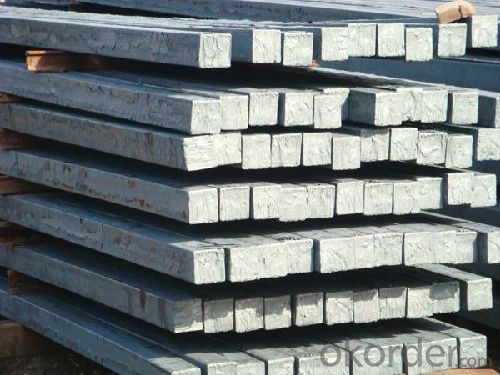

- Q: Can a steel square be used for chair rail installation?
- Certainly! Chair rail installation can indeed make use of a steel square. This tool, frequently employed in carpentry and woodworking endeavors, boasts remarkable versatility. It accurately measures and marks angles, lines, and lengths. Employing a steel square guarantees flawless cuts and angles for chair rail sections. Additionally, it aids in ascertaining the ideal height and positioning of the rail on the wall. While alternative tools exist for chair rail installation, the efficacy of a steel square remains unparalleled.
- Q: Can a steel square be used for checking the squareness of a door jamb?
- The squareness of a door jamb can be checked using a steel square. This versatile tool, known as a framing square or carpenter's square, is commonly used in carpentry and woodworking projects. Its purpose is to ensure accuracy and squareness in various construction tasks with its 90-degree angle. To check the squareness of a door jamb, simply place the steel square against the inside edge of the jamb, making sure that the 90-degree angle of the square lines up with the corner of the jamb. By visually inspecting the alignment of the square against the jamb, any deviations from a perfect 90-degree angle can be detected. If the steel square reveals that the jamb is not perfectly square, adjustments can be made to achieve proper alignment. This might require shimming or trimming the jamb to obtain the desired squareness. Overall, a steel square is an invaluable tool for checking and correcting the squareness of a door jamb, ensuring that the door fits properly.
- Q: How do you use a steel square to determine cut angles?
- To use a steel square to determine cut angles, you can follow these steps: 1. Place the steel square on the material you want to cut, aligning one edge of the square with the edge of the material. 2. Find the angle you want to cut and locate the corresponding angle on the steel square. The steel square typically has a protractor scale on one of its sides. 3. Once you have located the angle on the steel square, mark the material using a pencil or a scribe along the edge of the square. 4. Double-check the alignment and ensure that the square is securely positioned before making the cut. By using a steel square in this way, you can accurately determine and mark the desired cut angles on your material, ensuring precise and consistent cuts.
- Q: Can a steel square be used for welding?
- Indeed, welding can make use of a steel square. A steel square, known for its versatility, is frequently utilized in welding tasks to guarantee precise measurements and right angles. It serves as a guiding tool to thoroughly inspect the alignment and squareness of weld joints, ensuring their proper placement and welding at a 90-degree angle. Moreover, a steel square can be employed to measure and mark materials before cutting or welding, guaranteeing meticulous dimensions. In summary, a steel square plays a vital role in the welding process as it assists in attaining top-notch and precise welds.
- Q: How do you use a steel square to find the center of a circle?
- To use a steel square to find the center of a circle, follow these steps: 1. Place the steel square on a flat surface, ensuring that it is level and perpendicular to the ground. 2. Position the circle whose center you want to find on top of the steel square, making sure that it is also flat and stable. 3. Locate the two sides of the steel square that are perpendicular to each other. These sides are typically labeled as the blade and the tongue. 4. Align the blade of the steel square so that it is tangent to the circumference of the circle at any point. 5. Rotate the circle while keeping the blade in contact with the circumference. As you rotate, you will notice that the tongue of the steel square will intersect the circumference at two points. 6. Mark these two points on the circumference of the circle. 7. Draw a straight line connecting the two marked points on the circumference. 8. Repeat steps 4 to 7 at a different tangent point on the circle. 9. The intersection of the two lines you drew in steps 7 and 8 is the center of the circle. By using a steel square in this manner, you can accurately determine the center of a circle. This technique is particularly useful in woodworking, construction, and other applications where precision is crucial.
- Q: How do you use a steel square to lay out a right angle?
- To use a steel square to lay out a right angle, you would place the long side (blade) of the square against one side of the object or surface where you want the right angle. Then, you would align the short side (tongue) of the square with the other side, making sure it is perpendicular to the blade. Once aligned, you can mark along the edges of the square to create a right angle.
- Q: What is a steel square?
- Carpenters, woodworkers, and builders rely on a versatile tool called a steel square to ensure precision and accuracy in their woodworking and construction projects. Made primarily of steel, this tool comprises a long blade with a ruler marked along one edge, as well as a shorter perpendicular blade affixed to one end of the long blade. Its design allows for accurate measurements, angles, and straight lines. The steel square finds application in various tasks such as measuring and marking right angles, laying out stair stringers, checking for squareness, and determining angles for miter cuts. Without a doubt, the steel square stands as an indispensable instrument for these professionals, providing them with the means to execute their work with utmost precision and accuracy.
- Q: Can a steel square be used for measuring angles in electrical work?
- Yes, a steel square can be used for measuring angles in electrical work. While steel squares are commonly used in woodworking, they can also be useful in electrical work for measuring and marking angles on materials such as conduit, junction boxes, or metal plates. However, it is important to note that a steel square typically has markings for measuring 90-degree angles and not other specific angles commonly used in electrical work. Therefore, while it can provide a rough estimate, it may not be as precise as specialized tools like a protractor or an angle finder.
- Q: What are some common misconceptions about using a steel square?
- There are several common misconceptions about using a steel square that are worth addressing. One common misconception is that a steel square is only used for right angles. While it is true that a steel square is excellent for measuring and marking right angles, it can also be used for a variety of other tasks. For example, a steel square can be used to determine the pitch or slope of a roof, lay out stair stringers, or create parallel lines. Another misconception is that a steel square is difficult to use. While it may seem intimidating at first, with a little practice, using a steel square becomes second nature. There are numerous resources available, such as tutorials and videos, that can help beginners understand the basics of using a steel square. With time and practice, anyone can become proficient in using this versatile tool. Furthermore, some people believe that a steel square is outdated and has been replaced by digital measuring devices. While it is true that technology has brought us a wide array of measuring tools, the steel square remains a reliable and accurate option. Its simplicity and durability make it a staple in many professional trades, such as carpentry and masonry. Moreover, it does not require batteries or calibration, making it a cost-effective and dependable tool. Lastly, some individuals assume that a steel square is only useful for professional builders or craftsmen. However, this is not the case. Whether you are a DIY enthusiast or a professional, a steel square can be a valuable addition to your toolbox. Its versatility and ease of use make it an excellent tool for a wide range of projects, from simple woodworking to complex construction tasks. In conclusion, there are several misconceptions about using a steel square. It is not just limited to right angles, it is not difficult to use, it is not outdated, and it is not exclusively for professionals. Understanding these misconceptions can help individuals appreciate the usefulness and versatility of this timeless tool.
- Q: How do you use a steel square for creating precise spline joints?
- To use a steel square for creating precise spline joints, first, measure and mark the desired length on both pieces of wood. Then, align the steel square against the edge of the wood, ensuring it is perpendicular to the surface. Next, draw a line along the edge of the steel square using a pencil or a marking knife. Repeat this process on both pieces of wood. Finally, align the marked lines and cut along them to create precise spline joints.
Send your message to us
Stainless Steel Square Bar with Grade Q235 and Q275
- Loading Port:
- China Main Port
- Payment Terms:
- TT or LC
- Min Order Qty:
- -
- Supply Capability:
- -
OKorder Service Pledge
OKorder Financial Service
Similar products
Hot products
Hot Searches
Related keywords
